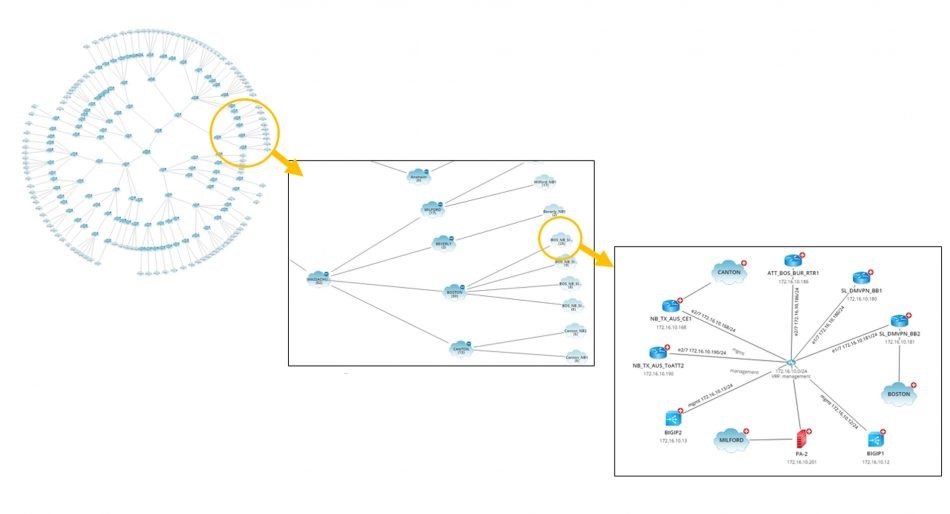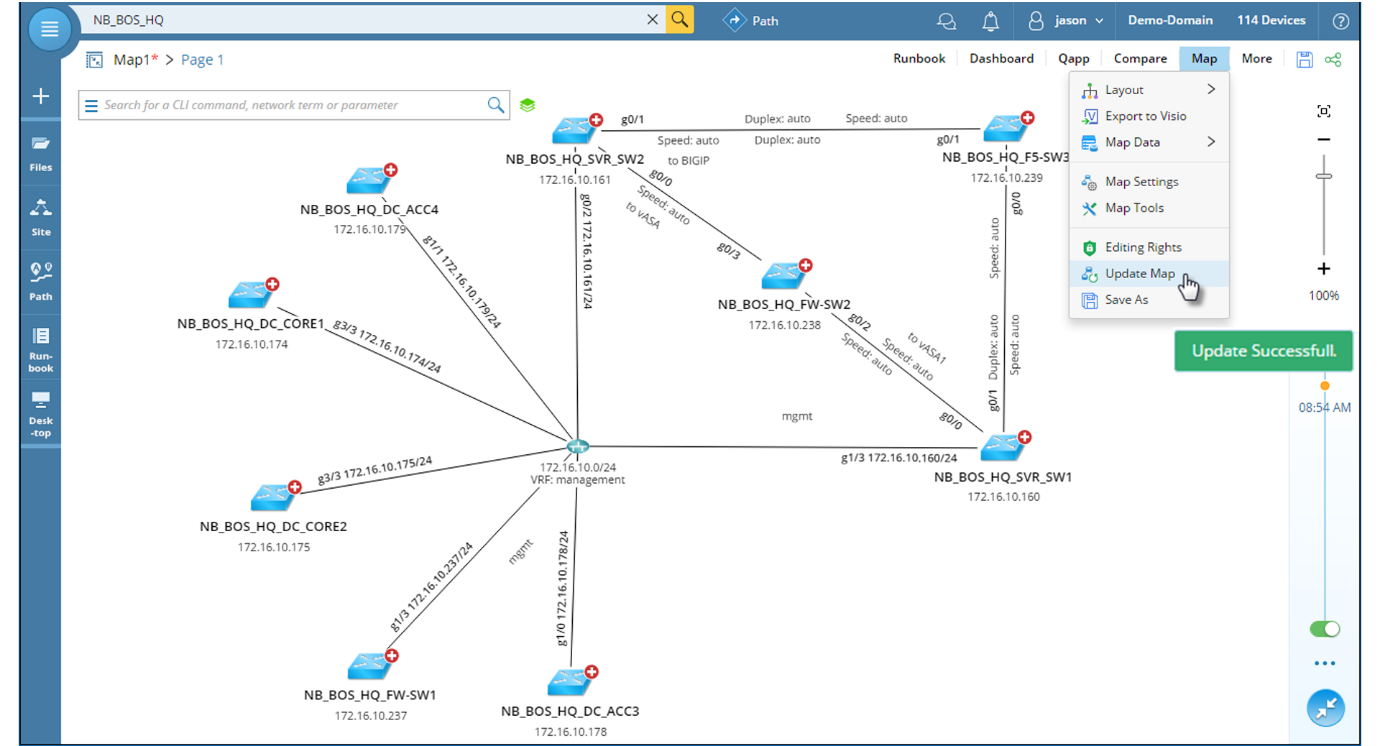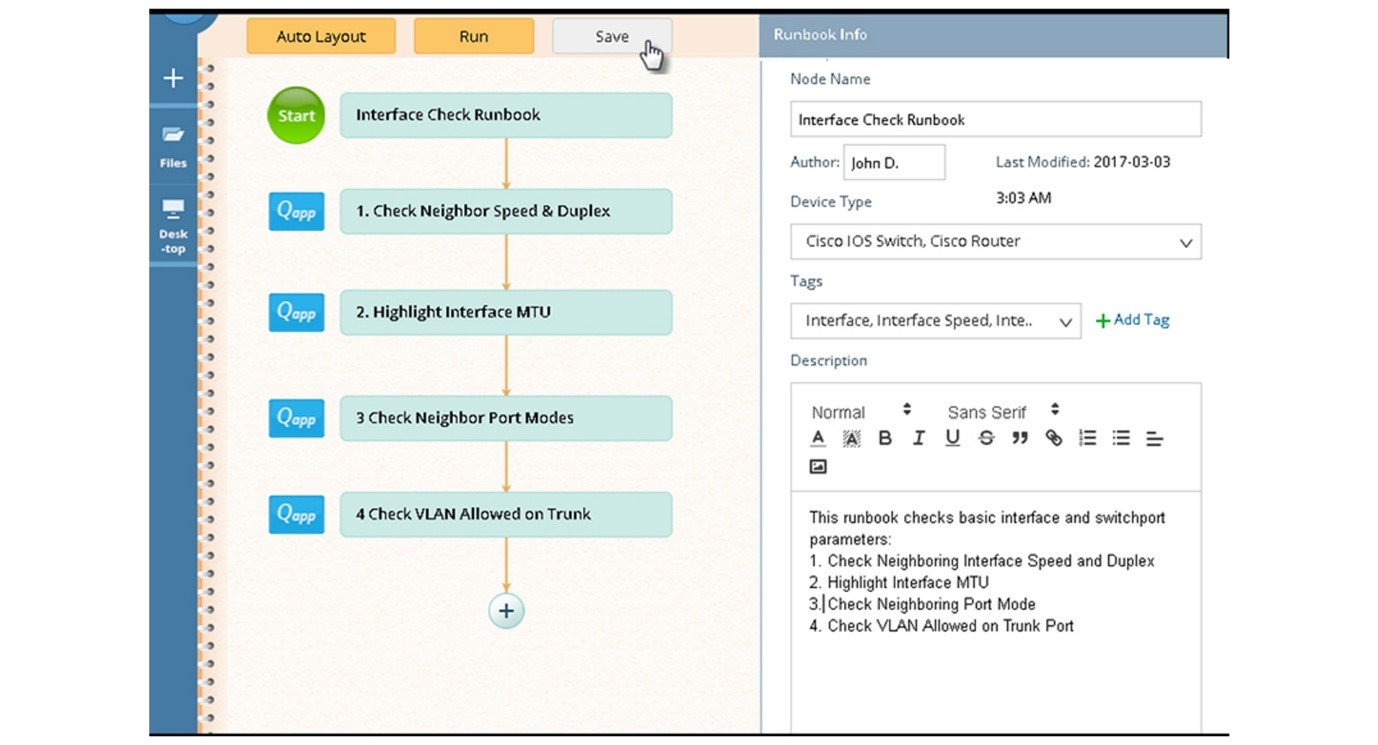Static Network Diagrams – Are you still creating them?
In my day-to-day Business Development role at Prosperon Networks, I speak to many different IT specialists who spend their day working on their potentially static network of their organisation. One common theme that I’ve encountered, that has led me to write this article, is that the vast majority of these IT specialists I speak to, tell me that they don’t have anything in place to help assist with documenting their network – making it unable to not be static. It is a very manual process, and other than the occasional use of Microsoft® Visio to offer some assistance, the majority of people I speak to are documenting their entire network by hand.
Although the time taken to manually document their network is consuming, this is not the only challenge they are facing when documenting their network. One common theme amongst the engineers that I speak to is that with the ever-growing complexity of their networks, they find that by the time they have actually made a change to the network and documented it, something new has happened or changed, and the documentation they just created manually by hand is now obsolete and outdated.
I have compiled a selection of questions and answers below that I hope will give you some insight as to how NetBrain® can assist your organisation to simplify network documentation.
Q1: Documenting the network is traditionally labour intensive and time-consuming. How can NetBrain help?
Traditional methods of documenting the network, either by hand or even with the assistance of Visio, are very manual and time-consuming.
NetBrain helps eliminate these pains via its automated network documentation capabilities. By automating the process of network documentation, NetBrain not only enables you to save time and money, but to reduce the errors that come with manual mapping, and to ensure your network diagrams are always up to date.
Q2: The network constantly changes but a traditional network map is static. How does NetBrain make network documentation more useable compared to a Visio map?
With the complexity and constantly changing nature of today’s modern enterprise networks, many network teams struggle on a day-to-day basis to have accurate visibility of their network with traditional static maps.
Tools such as Visio are not enough to accurately document the network, and there are some key reasons as to why this is the case.
- Manual to Create – The traditional method of mapping your diagram, is a manual 2-step process of collecting data, and drawing the diagram.
- Impossible to keep up to Date – Given the dynamic nature of modern networks, typical “static” diagrams are instantly outdated.
- Never the right amount of Detail – Traditional diagrams are either too bare or too cluttered to help with most tasks.
NetBrain’s dynamic mapping alleviates these pains and gives you an accurate representation of your network which a number of key elements.
- Automate Mapping – With on-demand mapping, you can now have the right map for any given task with just a few simple clicks.
- Visualise any Data – Data views provide a method to display device and interface data from many sources. Toggle your data views on or off to decode network design or access data from your other network tools.
- Accelerate Troubleshooting – Many network issues require troubleshooting between two endpoints, NetBrain’s A/B path calculator can instantly map any path across the network. The resulting map is a powerful troubleshooting console.
Q3: What data can be visualised on NetBrain maps? Can CLI data be included? What about data from monitoring solutions like SolarWinds, etc?
Most organisations have multiple network management tools, that are being interacted with on an individual basis; there is no single pane of glass.
Traditional monitoring solutions such as SolarWinds monitor the network for many symptoms and proactively raise alerts when conditions deviate from baselined network traffic. Once an alert is raised, however, it is typically up to the engineer to investigate this further and discover the root cause of the problem, identify a solution to this problem, and ultimately to apply the fix. Although the monitoring tool has done its job, it does not provide enough information to direct the engineer to the exact cause.
NetBrain integrates with your existing network management tools and IT workflows, such as network troubleshooting, design engineering, cyber defence, and application performance management, to provide valuable insights, minimising the time engineers spend in the command-line interface, or analysing data across disparate tools. NetBrain employs a Dynamic Map as the single pane of glass for data visualisation, and Executable Runbook technology to automate the process of data analysis.
4: How Can NetBrain’s Dynamic Maps Be Used To Solve Network Issues Faster?
Effective troubleshooting requires a combination of both experience and in-depth knowledge of the network’s diagram. Even when a network engineer possesses both, there is still the challenge of diagnosing network symptoms, which involves a lot of manual data collection and analysis.
The most common window an engineer has into the network is the command-line interface (CLI). Unfortunately, the CLI provides a narrow field of vision for engineers because the information they can gather is limited to the rate they can issue and interpret commands, one device at a time.
NetBrain helps to significantly reduce the time spent gathering information, and solving network issues through a number of factors.
- Dynamic Network Mapping – NetBrain’s dynamic maps mean they are automatically updated whenever the network changes. NetBrain diagrams can also be created on-demand, meaning engineers don’t need to sort through dozens of diagrams during an incident. Instead, they can instantly create a custom map focused on the event.
- Diagnostic Monitoring on a Live Map – NetBrain’s monitoring capabilities gives you the ability to visualise the performance and characteristics of each device and interface. This function can be turned on from any map, or even launched from a 3rd party monitoring tool. This gives troubleshooting engineers the ability to quickly spot bandwidth bottlenecks on the interfaces, or CPU/memory over utilisation on each device.
- Automated Change Analysis – NetBrain can be configured to benchmark the network regularly, so that network teams are better equipped to understand recent changes.
- Adaptive Network Automation – NetBrain eliminates the programming requirement from network automation with its “quick” programming environment. Engineers can literally point and click to program their own NetBrain “Qapps”.
Q5: Usually, when somebody leaves an organisation, so does their knowledge. How is human knowledge captured and made executable by NetBrain?
Many organisations have a dedicated team member that handles certain responsibilities, tools, or processes. This person usually tends to be the one that holds all the knowledge on a particular subject.
What happens when that particular person leaves the organisation, and the knowledge they possess leaves with them? The resulting impact is that organisations need to invest time and money to make sure someone else has the knowledge to take over those responsibilities.
How does NetBrain help eliminate this issue, and ensure that no matter who leaves the organisation, or what knowledge they hold, that the day-to-day operational tasks can continue to be performed as normal? NetBrain does this with Executable Runbooks.
NetBrain’s Executable Runbooks are interactive workflows containing executable actions which can perform complex network tasks. Executable Runbooks provide your organisation with a simple, scalable method of achieving automation and empower your network team to do more with less.
Q6: How do NetBrain’s Executable Runbooks work?
- Build It – Build runbooks for network processes in seconds, or let NetBrain automatically create one while you perform tasks on the network.
- Run It – Quickly automate operations such as CLI commands, path analysis, and data visualisation anywhere on your network.
- Share It – Have your network experts codify advanced knowledge into runbooks and empower junior operators to work independently.
What are some of the benefits that NetBrain’s Executable Runbooks can offer?
- Accelerate Troubleshooting – Reduce Mean Time to Repair by 50% or more.
- Document Workflows Automatically – As you troubleshoot an issue on a Dynamic Map, all the steps are automatically recorded in a runbook.
- Make Knowledge Executable – Allow the experts to codify their knowledge and share it with the rest of the team to empower them to work independently.
- Trigger “Just-In-Time” Automation – When NetBrain receives an alert from your monitoring tool, security tool, or incident management system it can trigger a first-response diagnostic Runbook that collects info from the affected area before the engineer starts working on it.
- Program Visually – Engineers won’t need to write a single line of code to automate network operations.
- Write Once, Execute Anywhere – Once a Runbook is created for one area, you can execute the same Runbook anywhere else in your environment.
Product Trial: NetBrain Integration Edition
Thank you for reading and I hope you enjoyed it. If you would like to learn more about NetBrain and how dynamic mapping can help you, give us a call on 01903 340993 or email us at info@prosperon.co.uk.

Darian Amirpashaie
Business Development
As part of the Business Development team at Prosperon Networks, Darian spends his time helping customers to optimise their IT Management capabilities, as well as keeping them up-to-date with the latest technologies and products.
Product Trial: NetBrain Integration Edition
Related Insights From The Prosperon Blog
Don’t get lost! Mapping your Network with SolarWinds
Heard of SolarWinds Intelligent Maps and never known where to start with them? You’re in luck! Join us as we chart a course……sorry I couldn’t resist! Let’s navigate through...
The Critical Role Of The Trusted Advisor In NetOps
Before there was “Network Operations” there were networks. Networks grew out of a need for connecting one box to another, sharing printers, and for more advanced users,...
Webinar On-Demand: Beyond Monitoring – Introducing SolarWinds Observability Platform
In this webinar, you will discover how SolarWinds® is evolving to deliver complete infrastructure visibility. This webinar examines how to extend visibility across your IT...





